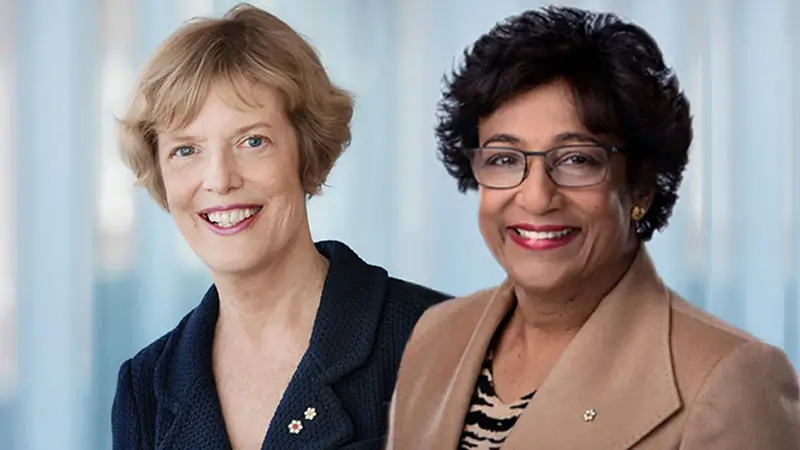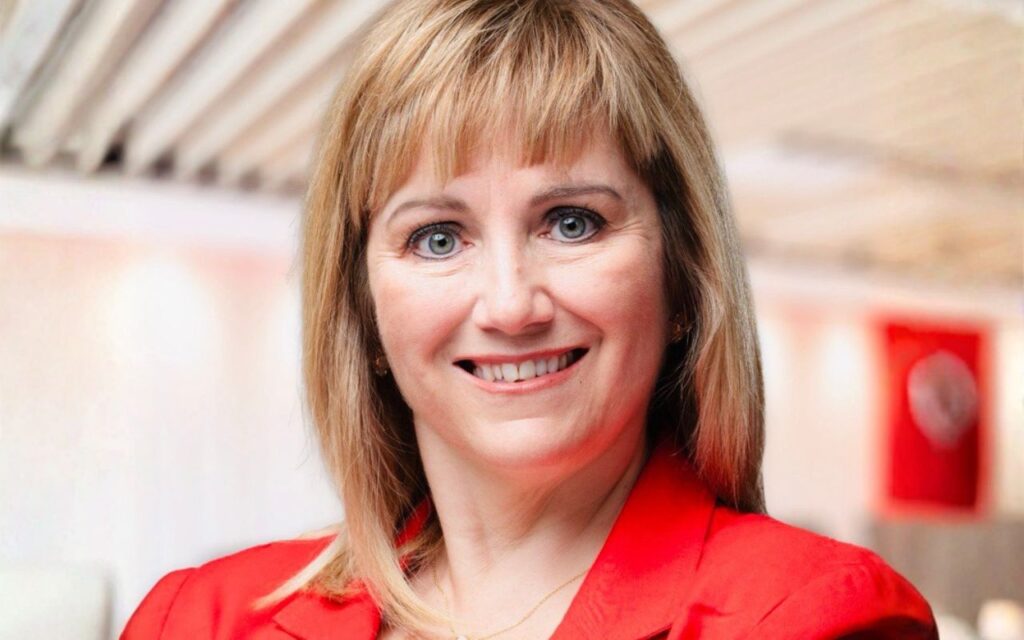
Nervy decisions and the book-writing process
Jennifer Stewart: Martha, why do you think women need a bit of nerve?
Martha Piper: We’ve thought a lot about that. Women are often reluctant to do things that go against the grain, whether it’s taking on leadership positions, making difficult decisions, or moving an organization forward in a different direction. The word nerve captures that, because it requires action. It’s different than courage. You can be courageous but not have the nerve to actually do something. And so we thought nerve really described the trait women need to have to lead.
Catherine Clark: What’s the nerviest decision that you’ve made in your life or your career?
Indira Samarasekera: I think the nerviest decision that I made, when I think about my career, was going from an academic who had, taught, done research and been in a classroom to becoming Martha Piper’s vice president, research with absolutely no managerial experience. It was like diving off the high end of a diving board when you don’t know how to swim.
Jennifer Stewart: What was the process like writing the book?
Martha Piper: It is a birthing process. And believe me, we had no idea the work involved. As much as I love Indira, we have already taken a blood oath that we are never doing this again.
Catherine Clark: Was it really very difficult?
Martha Piper: It was a lot more work than we thought. I don’t want to say we’re perfectionists, but we pushed each other. And, you know, it’s very threatening to disclose about yourself as much as we did. And of course, as you know, if you’ve read some of the things we talked about that we encountered when we led, we had to seek legal advice. Yeah, it was a lot of work, but it was also gratifying. There’s no question about it.
Catherine Clark: Well, it’s just wonderful that now it’s behind you. Now all you need to do is agonize the night before the release, thinking, “Oh, gosh…”
Martha Piper: It’s very scary. I always say speaking is cheap, but the written word is there forever.
Indira Samarasekera: Our stories are unvarnished; we did not want to sugarcoat anything. My ex-husband is a good friend now. I said to my daughter, “I wonder what he’s going to think,” and she said, “It doesn’t matter what he thinks. It’s your story.” And I think that applies to all of the stories that we put in.
Catherine Clark: It’s so important that women do tell their stories because there’s true isolation and questioning of purpose when you think you’re the only one going through something.
Martha Piper: When I assumed the presidency back in 1997, I looked around for books on leadership. And they were all written by men, and especially university leadership. And one of the things I’d like to say is this book is not about university leadership. It’s about leadership generically. But would we have wanted to have read this book when we were struggling to become leaders? And we hope the answer is yes.
Women in leadership
Jennifer Stewart: Do you think that women and men view leadership differently?
Martha Piper: Nothing is generalizable to everyone. But I do think, after observing men leading in the corporate and nonprofit sectors and watching and being part of women leading, there are some differences. Women tend to be more collaborative; they tend to want to reach a consensus and consult more rather than just coming to a quick decision. Women, maybe negatively, are much more concerned about being liked when they lead, and hence, they try to please everyone, which is almost impossible in a leadership position. Whereas men, you know, they don’t worry so much about it; they know it won’t be taken personally, and they just move on. So those are some of the things that I’ve observed.
Catherine Clark: Indira, how do you get over the need to be liked as a woman in a leadership capacity
Indira Samarasekera: I think it’s about a constant conversation you have with yourself, that when you’re faced with a difficult decision, or there is a discussion going on, first of all, to say what is in the best interest of the organization? I’m just going to suppress this feeling that rises in me as I begin to intervene in a way that’s not going to be popular. And it gets easier with time. The more you practice
the business of not being liked, the more you get comfortable with not being liked. I found that when I became President of the University of Alberta, initially you’re new to the city, you’re new to the institution, you want people to like you. But pretty soon you have to decide if you’re going to move this organization or if you want this business of being liked.
Martha Piper: Could I add that there’s a big difference between wanting to be liked and needing to be liked? It’s okay to want to be appreciated. But it’s not okay to need to be liked. And women fall into that trap. Women also think if they do the right thing, if they are leading well, then they’ll be liked, and when they end up not being liked, they think they have failed in their leadership. And that’s an issue that I think men don’t necessarily face.
Jennifer Stewart: You ask a really interesting question in the book about whether women are born or bred to lead. What’s your answer to that?
Indira Samarasekera: It’s absolutely about breeding. Obviously there are some women and men born with certain characteristics that may make them more suitable for leadership, but Martha and I found that we shared everything from having nurturing families and fathers to role models to our early experiences and being encouraged to lead. So, it’s about being bred as opposed to born. Martha, do you want to add anything there?
Martha Piper: It’s very interesting. Most people will ask us, are you firstborn? But when we began to put all those pieces together, this issue of birth order fell off the agenda. And when you look at other leaders, you see specific patterns where they have siblings or a parent has played a role or a significant other person in their life has played a role. The other thing we both had were very large extended families who nurtured us: grandparents, aunts, uncles, and cousins. So you know, that’s why we say a crucible of family. I think family does play a role.
Catherine Clark: There are some women who don’t have the support structure that we have all grown up taking for granted. What can they do? Who do they turn to for that support? What do you recommend for them?
Martha Piper: Well, it’s always difficult to generalize, but I do think people need a support structure, particularly women. And so I would suggest that they look around in their lives and their environments and find individuals whom they trust, respect, honour, who they can look to, to guide and assist and present an example of the kind of aspirations they want to have. Also, in the book we differentiate between mentors and sponsors. When Indira and I looked at our pattern, we found sponsors – people who watch you, who observe you, who think highly of you, who then go out and advocate for you and present you and nominate you – really make a difference in your path. So, to women, keep your eye on the mentors you’ve identified and the people who are going to sponsor you, moving you forward.
Jennifer Stewart: In the book, you talk about best-laid plans. Why did you include that idea?
Martha Piper: I think women are very good at planning. We plan everything. We design our menus; we plan our dates, days, and schedules; we make lists; we think we are in control. And what we fail to recognize is that even those best-laid plans often go astray. And dealing with those changes in direction is really important instead of sticking to that plan. I grew up years ago, and my best-laid plan was only to be a mother and a wife.That was very clear. And it took a great deal of stress and strain to realize that that plan was not going to work. Had I just stuck to that plan, I probably would have had a much unhappier and less fulfilling life. The recognition that you can only plan so much, and things start to happen and fall into place – that’s what we call serendipity. You have to be able to put those pieces of the puzzle together and recognize that there’s maybe a different path for you to follow.
Key lessons from the book
Catherine Clark: Indira, there was a really interesting part of the book where you talk about your decision to leave your marriage. Can you talk to us a little bit about what that process was like for you?
Indira Samarasekera: Yes, thank you for asking that question. The process was torture. I was in a country with no family support. My parents lived in Sri Lanka. I had friends, but it’s a very lonely experience when you’re making that kind of personal decision. That is part of this best-laid plan. I thought my husband and I had a lot in common intellectually, and so the last thing I expected was to come to the very painful realization that I was unhappy on a daily, hourly basis. And in those circumstances, you have to combine the emotional with the rational. And emotionally, I was very unhappy. But rationally, I had the seesaw about, should I leave? Should I stay? But somewhere in my gut, I knew I had to get out. And I say to young women, it takes nerve. It looks like it’s going to be a terrible outcome. But my experience was I made the right decision at the right time to get out early when my kids were young and I could rebuild a life.
Jennifer Stewart: Do you think having regrets is a problem? Or can it teach us something positive?
Martha Piper: I tend to be an optimist and always see the silver lining, which has often gotten me into trouble. But I don’t think regrets serve a great deal of purpose. You just need to accept things as they evolve and move on. It’s very difficult if you live in the past and keep thinking if I’d only done this or I’d only done that. I don’t know how you move away from being unhappy if that is how you see the world. If you ask me, do I have regrets? I’m sure I do, but I don’t think about them. They don’t drive me.
Catherine Clark: I want to jump to appearance. No matter how smart we are, or how good we are at our job, what we’re wearing, how our hair looks, or what kind of makeup we’re wearing is still a focus for some of the people around us. How did that play into your professional paths?
Indira Samarasekera: Yes, it plays a critical role. For me, one of the issues was coming from a cultural change. I came from a culture where women wore sari or long dresses and covered their heads and all that sort of stuff. My first challenge was to dress like a North American with no prior guidance because girls learn from their mothers, and they learn from role models. But what I learned over time was, first of all, you dress to please yourself. You have to have a certain confidence that comes with looking good. That doesn’t mean you have to go out and splurge. But it’s really important because it boosts your confidence. Secondly, you have to dress to respect the position you’ve been given, whether at the workplace, in a nonprofit organization, or on a corporate board. And the combination of those two is critical in determining how to dress.
Martha Piper: Yes, appearance shouldn’t drive your priorities, but it needs to be considered. I grew up in a family where dress was not important, and I lacked confidence in my appearance. But as I moved along, I began to recognize that it’s not so much how others see you; it’s how you see yourself. And your appearance and how you present yourself speaks volumes about the respect you have for the position that you’re representing.
Jennifer Stewart: What did you learn about yourselves through the process of writing the book?
Indira Samarasekera: I learned even after you’ve made certain progress or achievements, you still have self-doubts. And what I learned was that self-doubt or that insecurity is actually an asset. I’ve come to the conclusion that you have to look at it as an asset, the fact that – I think Martha and I share this trait – the fact that everything has to be to one’s highest standard is not a bad thing. Now, wanting perfection is a great pitfall for leaders, for women, for all kinds of reasons, but there is no harm in having a standard and feeling inadequate about reaching that standard. I think it’s a core driver of excellence, of wanting to do better, of setting a goal that you can then work towards.
Martha Piper: I’ll take a little different view of it. The best part of writing this book was writing it with Indira. I know down to my deepest depths that this book would not have been written as it was if I had written it alone. It is so much better. Because I got to know Indira, we worked so beautifully together in trying to figure out certain ideas. She changed my views on many things. We developed an incredible friendship. And, you know, the best part of writing the book was being part of her life and learning from her. It’s always tricky when there are two voices, but we complemented each other. We certainly drew upon each other’s experiences, strengths, and resources as we tackled some of the issues that we thought were pretty important for women.
Indira Samarasekera: Yes, it was the gift of a lifetime. The mutual enrichment, understanding, and perspectives we developed about our own lives, about leadership, and about each other was just an amazing gift.







